![]() Sources
Sources
![]() Illustrations
Illustrations
![]() Engravings
Engravings
| Back to . . . |
This section . . .
|
|
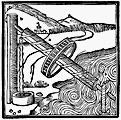
|
A woodcut from an edition of Virtruvius’s De Architectura published by Fra Giocondo (c.1445-c.1525) in Venice in 1511.
Enlarged images: |

|
A woodcut from the small Junta edition of Virtruvius’s De Architectura published by Fra Giocondo (c.1445-c.1525) in 1522.
Enlarged image: |
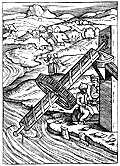
|
A woodcut from an edition of Virtruvius’s De Architectura published by Daniele Barbaro (1514-1570) in Venice in 1567 (see page 348).
Enlarged image: |
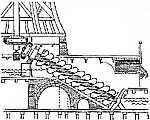
|
Two illustrations from The Dutch Windmill by Frederick Stokhuyzen (1861-1976), translated from the Dutch into English by Carry Dikshoorn (Universe Books, New York, 1963, 128 pages). Originally published in Dutch by CAJ van Dishoek-Bussum-Holland in 1962 under the title ‘Molens’.
This richly illustrated book relates the history of the Dutch windmill and describes many types of windmills and their operations. According to Stokhuyzen, the Archimedes screw was used in windmills for drainage beginning in 1634. Full-size versions of these two thumbnail images are available at a site containing a Web version of the book. |
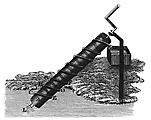
|
An engraving from an unknown source. This engraving illustrates how a simple Archimedes screw can be made from a flexible tube, such as a garden hose, wrapped around a cylinder.
Enlarged image: |
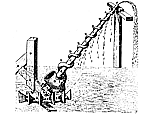
|
An engraving from an unknown source.
Enlarged image: |
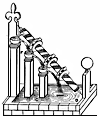
|
A woodcut scanned from “The perpetual search for perpetual motion” by Doug Stewart (Smithsonian, Volume 17, November 1986, pp. 193-208). An Archimedes screw lifts water which then falls, driving paddles which turn the screw. The drawing is as poorly executed as the concept. In particular, the artist has the screw rotating in the wrong direction.
Enlarged image: |
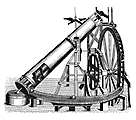
|
Another engraving scanned from “The perpetual search for perpetual motion”20 by Doug Stewart (Smithsonian, Volume 17, November 1986, pp. 193-208). An Archimedes screw lifts ball bearings which drive a wheel to turn the screw. Quiz: Does the artist have the blades of the screw spiraling in the correct direction? Would your answer be the same if the engraving displayed has had its left-right orientation inadvertently flipped from the original’s?
Enlarged image: |

|
Yet another perpetual-motion machine, this one from a 1580 woodcut. Water from the trough drives the water wheel which turns a grindstone and an Archimedes screw to lift the water back to the trough. The screw is inclined much too steeply to form the “pockets” of water needed for it to lift the water.
Enlarged image: |
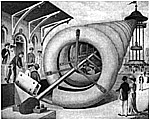
|
An idea, probably never consummated, for an amusement ride. Riders travel on a cart up the inside of an Archimedes screw. Originally described in Scientific American, Vol. XCI, No. 26, December 24, 1904, page 467. As the article effuses: “The apparatus should afford considerable entertainment.”
Enlarged image: |
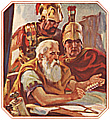
|
An illustration from a magazine advertisement for a 1927 Packard automobile. The caption reads, “The Greek mathematician and inventor, Archimedes, discovered and used many of the principles of mechanical engineering two hundred fifty years B.C.” The text of the ad states in part, “The spiral bevel gears, which Packard developed and was the first to use commercially, are based on the principle of Archimedes’ screw—in use 2,000 years ago.”
Enlarged images: |

|
The logo of the Grundfos Group, an international manufacturer of pumps and pump accessories. Their logo is based on the woodcut in Barbaro’s edition of Virtruvius’s De Architectura shown above.
Enlarged image: |

|
An animated figure from the home page of Spaans Babcock Ltd., a Dutch manufacturer of screw pumps.
Quiz: Is the screw rotating in the clockwise or counterclockwise direction when viewed from above? |